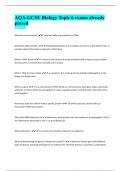Financial Accounting
Summary 2020-2021
Source: Financial and Managerial Accounting by Weygandt,
Kimmel & Kieso (Third Edition)
,Accounting
Lecture 1
Accounting is information to:
- Make decisions as a firm (prices, investments, strategy)
- Make decisions as investors, as banks
- Determine tax payments
Accounting provides information to
- Make decisions
- Inform people having an interest in the firm (investors, owners, employees)
- Fulfill duties to society (pay taxes)
- Summarizes all kind of actions, decision, results, transactions into figures to steer
the business and inform stakeholders
Accounting is one language, with many dialects. IBM: net income on the basis of US
accounting principles. Fujitsu: net income on the basis of Japanese accounting principles.
What generally accepted accounting standards to use?
- US: U.S. GAAP – FASB
- Europe: IFRS – IASB
Why differences?
- What is the truth? What is the actual value of a machine you bought?
- So standard setters make a rule based on how users of accounting information get
the most relevant and reliable information.
Financial accounting: external financial reporting and bookkeeping (for stakeholders)
Management accounting: internal information for decision-making, performance evaluation
and control
1
, Financial accounting has three statements:
Each angle shows a different element of the business.
Balance sheet: overview of the firm’s situation at a point in time
- Assets: what the firm owns: what it has done with the funds it received
- Liabilities: what the firm owes: where the funds came from. Split into equity (funds
from owners) and other liabilities.
Profit and loss statement: the results of a company over a period of time
Cash flow statement: the flow of money into and out of the company over a period of time
2












